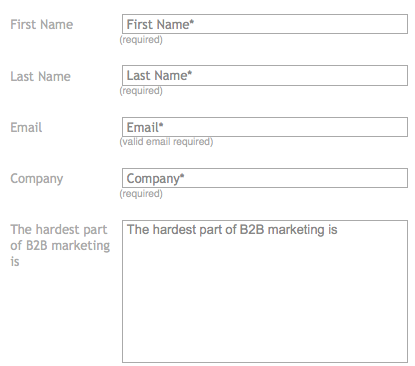We’ll start out latest update with a terrifying statistic for anyone who’s been following our Open Robe from day one – it’s already a month old. Where did that go?
But with one rapid one month on the B2B Marketing Manifesto clock and five still to run, we have much to report:
- 453 downloads from a target of 1000
- 2 serious new business discussions from a target of 2
- 1 new project with existing client from a target of 3
- 40 comments from a target of 50 (get involved, shoot from the hip)
- 222 per cent rise in views of our existing content library
We’ve long-term metric mountains to explore, but we’re still on track and morale at basecamp Velocity remains high.
Today as promised, we start our investigation into the impact of web forms.
The Form Factor
The rise and rise of lead generation programmes underpinned by, let’s be honest, amazing marketing automation tools has seen the number of data hungry forms multiply. A digital curtain has descended across B2B content.
Is it a good thing? On one hand, you can’t nurture a lead you don’t know anything about but, on the other, you don’t want to prevent people learning about your company and its services.
What have we learned? Well, our form has vanquished over 50 per cent of our traffic.
Some may argue that 45 per cent is a decent conversion rate. And if this was everyday web traffic I’d probably agree with them. But it’s not. Most of these people have come, with super-high intent but didn’t download. They came, they saw the form, and they left.
Let’s take a look at the culprit.

It’s not your text-book form villain: it’s not acting like an identity thief and it’s not threatening an unsolicited phone call within 24 hours. Yet despite all it’s benevolence we still lose over 50 per cent of our traffic (worth mentioning again, I think).
Lessons Learned
If your content is always guarded by forms that growl at prospects like a watchful sentry, then you are taking a big risk.
We have three new business leads and they’ve all contacted us after reading the Manifesto. If they’d never read it; they’d probably never heard of us, and we would certainly never have heard from them.
When you’re selling your thinking, processes and services, there’s something to be said for not hiding your content behind a 24 field bushel. Sometimes opening your own robe is the right thing to do.
Will the form fight back?
Next week we’ll start to explore the other side of the coin as we start to nurture our own database, much of which has been built up with permission using forms. We’ll report back as soon as we get an idea of the pros as well as the cons of asking for information.
Let hot war commence.
Want the full Open Robe picture?
Project Open Robe Part 1 – the one where we commit ourselves in public (Planning)
Project Open Robe Part 2 – the one where it all kicks off (Thinking)
Project Open Robe Part 3 – the one where confidence starts to rise (First results)
Project Open Robe Part 4 – the one where the trick shots start (Cross-promotion)
Project Open Robe Part 5 – the one where we share the first month’s results (Reviewing)
Project Open Robe Part 6 – the one where we toughen up (Soul Searching)
Project Open Robe Part 7 – the one where we find the world’s best marketers (Segmenting)
Project Open Robe Part 8 – the one where we show that design isn’t everything (Style v Substance)
Project Open Robe Part 9 – the one where lead nurturing proves its worth (Marketo)
Project Open Robe Part 10 – the one where the form fights back (Form v No Form)
Project Open Robe Part 11 – the one about autoDMs in Twitter
Project Open Robe Part 12 – the one about re-purposing and atomising your content
Project Open Robe Part 13 – the one with an early peek at the outcomes
Project Open Robe Part 14 – the one where it ends (before it starts again)

Enjoyed this article?
Take part in the discussion









Comments
There are no comments yet for this post. Why not be the first?